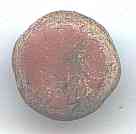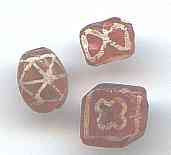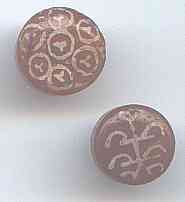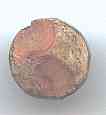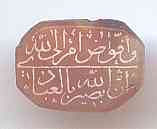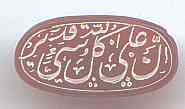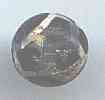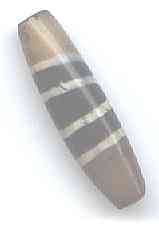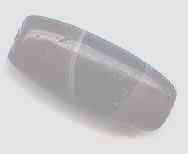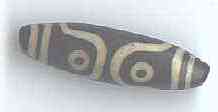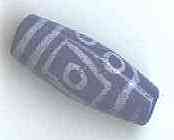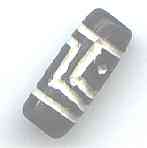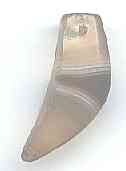PROTECT DZI BEAD FOR TIBETAN TRAVELLERS !!
EXTREMELY RARE & GORGEOUS ANCIENT DZI BEAD from BHUTAN
This beautiful bead was found in
Expected corrosion and wear are a consequence of age and extended burial.
Some original sedimentary deposition has been retained on part of the surface.
150 YEAR'S OLD !!
SOMPTUOUS !! From Nepal, Tibetan Buddhist Dzi Bead !!!!
Extraordinnary item !! One of the rarest & precious Bead of the world... Natural Banded Agate, with luxuous cut, design & patina.
Dzi is a sacred Bead From Himmalaya , this one come from Kathmandou, directly from the Tibetan Mountains ,it's an exceptional item.
Very Fine Design.
Dimension: 52 x 17 mm Weight: 22,3 g !
gZi or dZi beads come from the central Asian region, and are usually found in an area ranging from Afghanistan, Iran, Tibet, India, Pakistan, Nepal and Burma.
They come in many shapes, sizes and forms, from tiny etched carnelians to huge multi eyed and striped dZi.
The photos in this collection are beads that I have personally collected in India and Nepal over the last 27 years.
When I first started collecting dZi, there were only original beads around 1000's of years old, or obvious modern copies and fakes not even made from agate, but usually bone or glass, so there was no mistaking the real from the copy. In recent times however the market has been inundated by so-called "middle period" or "antique" 100 or 200 year old dZi which the sellers are claiming to be genuine. This is simply not true. They are all modern copies mostly manufactured usually in China and Taiwan with certain techniques applied to them to "age" them, and as the market is flooded with these fakes I find it neccessary to clarify this. Ebay is particularly bad for the sale of fakes which the vendors sell as real. Some of these fakes are so good that even the Tibetans and "experts" themselves are frequently fooled. The way to spot fakes is with a good quality jeweller's loupe or eyeglass. How to detect fakes is outlined below.
HISTORY
There are also innaccuracies about the dating of the original "pure" dZi, the most common error is stating that it is 8th century. This error comes from a date found in the bead collector's bible "The History Of Beads" by Lois Sherr Dubin, where dZi is placed on the fold out "Time Map" in the 700's AD alongside the introduction of Buddhism in Tibet. However, if the reference numbers next to the beads are checked, the detail states that the actual dates are unknown. This is because the Tibetans have refused to allow archaelogical digs in Tibet, so no accurate dates can be established. The assumption is that as dZi is connected with Buddhism, then the stones arrived in Tibet at the same time Buddhism did.
In fact it is widely understood, certainly by the Tibetans, that dZi was part of the Bonpo tradition which preceded Buddhism in Tibet and goes back 4000 years or even more, and some of the oldest dZi is very likely to have come from this time. I have been told that the Bon Chiefs used to wear them on their ceremonial robes and when they died they were cremated in their ceremonial regalia, and the remains buried(though this cannot be proved). This would explain why gZi beads are often found in the ground and why so many are found burnt or broken, as the heat from the pyre would have been very likely to crack the beads.
This is not to be confused with chips in the beads, which could be accidental, but more likely to be deliberate. A recent conversation with a Tibetan from Lhasa revealed that beads were deliberately chipped either as medicinal offerings which is widely known, or to include as part of a burial offering on the death of the previous owner, which is not so well known. Therefore beads with small chips in them generally do not affect the value of the beads, and indeed can be seen as desirable.
There is another desirable feature to be found in dZi beads known as Blood Spots, or Martik to the Tibetans to whom these spots are extremely desirable.
POWER
As to questions about the power of the beads this is a very subjective matter, and I personally do not think that they have any intrinsic power bestowed by the Gods, like the Tibetans do, but having said that I always wear them when I am travelling. However, I do believe in the power of the mind, and quantum physics tells us that the universe only exists as we percieve it because of our beliefs, and those beliefs actually change how the atoms behave. Therefore the beads have the power we believe they have, and that power may be retained in the atoms of the stone. The older the bead and the more people who have held beliefs in the bead's ability to protect them, the more powerful the bead becomes. So it is a mixture of both natural science and belief, they work side by side. The new beads will have very little, if any, power at all, and none of it protective. The ones that have been deliberately faked to look old may have negative energy in them.
HOW WAS dZi MADE?
The great mystery of old dZi and etched carnelians is how they managed to get the markings on the surface without breaking or cracking the stone. The Chalcedony family, of which agate and carnelian are a part, are particularly suseptible to heat, which will crack or even shatter the stone. The technique of how to heat it without damaging it was only discovered in recent times by using sophisticated technology which entails heating the stone within a vacuum. As chalcedony is porous there is air and moisture within the stone which when heated expands and causes it to crack. In a vacuum the air has been removed so greatly reduces the chance of the stone cracking when heated. This technology was not around 100 years ago in remote Tibet, nor indeed was it around many of thousands of years ago, hence the mystery.
HOW TO SPOT CERTAIN FAKES
The most obvious sign of true ageing is the tiny circular cracks that appear on the surface of the bead to a greater or lesser degree depending of the density of the stone and its age. Beads that have been buried a long time will show this effect (see below), probably due to water getting in and then expanding and contracting due to seasonal changes in the climate.
Certain kinds of agate do not always show this ageing, agate that is very dense in its structure, and therefore the surface is less porous and less likely to be affected by this kind of age wear.
A lot of the modern copies also have these circular markings on them which is artifically created and the key to telling the difference between the modern and the old is to inspect the cracks with a 10 x loup or magnifying glass. On the original beads the circular cracks are rough and have a rounded edge to them where the crack goes into the stone, usually from being worn for millenia. The modern ones tend to have a sharp more squared edge to them where the stone's surface has been ground and polished after the ageing effect has been applied. Also the holes where the string goes are not worn or smooth and usually show a roughness.
Also a lot of the modern copies are too smoothly and perfectly formed, whereas old beads have natural dinks and chips that have been worn smooth over time to give an unfakeable effect.
HOW ORIGINAL PURE GZI/DZI WAS MADE
Many people have speculated as to how the original dZi was etched, as the modern technology of vacuums was not available at that time. One plausible theory was that the stones were heated at a extremely high altitude where the air is so thin that expansion is minimal. As Tibet is the highest country on the planet this gives some credence to this theory. This does not explain how the Indus valley culture etched carnelians though as this is not at altitude. However with the market flooded with huge quantities of replica and duplicate beads it seems very unlikely that all, if any, of these so called antique and middle period beads were made this way.
The process now of how the markings were etched into the pure dZi stones is fascinating. After the bead had been shaped and drilled, it was coated in Natron, also known as Hydrous Sodium Carbonate, and then baked which turned the stone white. The pattern of the eyes and lines were marked out with molten wax and the beads was then left to soak in a sugar water or other solution for approximately one month until the water had penetrated into the surface of the stone where it had not been covered in the wax. The stone was then heated again burning the sugar within the stone and turning it the familiar brown colour of most pure dZi. This method was somewhat hit and miss as the density of agate varied greatly, allowing more or less of the solution to penetrate, giving rise to variations in the depth of colour of the markings, a problem still happening today with the modern copies many of which have this mottled effect on them. Other chemicals were also used creating different colours, mostly this can be seen on the striped Chung dZi, which comes in a variety of different colours.
VALUE
One of the best ways to tell if you are being sold a fake is the price. Pure dZi with anything from one to nine eyes are worth from US$2,000 up to $15,000 or even more depending on the quality and condition, so any so-called pure eyed dZi you see on ebay for example, with a $10- $200 price tag is a modern fake, that the vendor may or may not know is real..... there are some cheats or idiots about!
Chung dZi, or lesser dZi, has such a huge variety of shapes, sizes and designs, from plain natural carnelian or striped agate, to huge, beads with many etched lines and patterns, that they would be impossible to value, although you can pick up old, unetched beads for as little as $10, or much less if you go to India, Nepal, or Tibet and you know where to look.
There are no damages and no repairs.
Expected corrosion, wear, degradation, minor losses and abrasions are a consequence of wear, extended burial and age.
Some original sedimentary deposition remains on part of the inside of this bead.
Guaranteed authentic!
One of the most intriguing aspects to these beads is how they have survived a hundred or more years of wear and the travel through at least three continents. Another mystery is who wore them before us who will have them next.......after us. We will chip to world wide, prioritar or economic as you want, contact us, we combine all additional items 0,50 euros.
Pour la France et l'europe tarif prioritaire et économiques.
Contact-me for all questions, it will be a pleasure to answer!!
This bead is 100 % genuine and is between 100 and 300 years old.
The Legend of Tibetan Dzi Bead
Dzi or Gzi (pronounced as “zee”) in Tibetan word mean “good retribution, dignity and perfection”. The authentic “Pure Dzi” and “Chung Dzi” are found primarily in Tibet, and the “dzi family” can be found in neighboring countries such as India, Bhutan, Ladakh, Sikkim and Nepal. The later are “etched carnelian” and the history can be traced back to 5000 years ago where its main sources were Mesopotamia, Afghanistan and India.
“Pure” dzi beads, in the traditional Tibetan system for evaluating dzi, are regarded as the most valuable and desirable variety.
Etched agate beads not considered pure are called “Chung Dzi”, or
“secondary, less important dzi”. Lastly, “etched carnelian” is not
recognized by the Tibetan. Chung dZi has such a huge variety of shapes,
sizes and designs, from plain natural carnelian or striped agate, to
huge, beads with many etched lines and patterns, that they would be
impossible to value.
Not all pure dzi comes in the shape of tube. The above goat’s eye dzi (Lumik in Tibetan language) is in round shape. This bead is the traditional and effective amulet for Tibetan when they are traveling.
Etched Beads and dZi Beads
The "etching" of beads is a misnomer, because alkalis, not acid is involved in their decoration. They are distinctive and much has been written about them. The two most important works are Etched Carnelian Beads by Horace Beck (1933) and Etched Beads in India by M.G. Dikshit (1949).
| Beck divided these beads into three periods. His Early Period (before 2000 BC) corresponds to the Harappan or Indus Valley Civilization, now dated to ca. 2600-1700 BC. This tabular etched bead was obtained in Egypt. Stylistically, it matches these old beads, but there is no way of knowing how old it is. |
His Middle Period (300 BC to AD 200) corresponds to what Indians call the Early Historic Period, now put at something more like 500 BC to AD 500. These are typical designs from that period. |
|
| His Late Period (500 to 1000 AD) is now understood to have been mostly the work of Persians, rather than Indians. The Indian industry survived, but few etched beads are found in India, being found in modern Iran and westward, traded into the Middle East and Russia. The design on the bead on the bottom is a well-known motif of the Persian Sasanian (2nd to 7th century AD) dynasty. |
Beck also recorded two types of etched beads. Type One has white lines on the red stone, as do the beads above. Type Two has black lines on a white bead as at left. |
|
| In some cases the original stone may have been white, as with this bead. The broken end shows that the stone was white (whether the bead above was or not, is hard to say). |
However, in most cases, Type Two beads are made from carnelians that have first been whitened all over and then had the black lines added. The broken side of this Persian bead shows that clearly. |
|
| Dikshit also designed a Type Three, which has black lines drawn directly on the red carnelian. These are extremely rare. He also noted two varieties of black on top of white figures and the two colors side by side. These are also very rare. |
What should be regarded as a variety has white lines on a darkened bead. These are usually considered to be "black agate," but all that I could examine are artificially darkened gray chalcedony (like this one) or carnelian. |
|
| There are also varieties not considered in these schemes. The Harappan Civilization experimented with different combinations. This is a small gray jasper bead that has been etched. Probably Persian. |
The last known Indian to etch carnelians was Saheb Dino of Sehwan (now in Pakistan). He was interviewed in 1930 by Ernest Mackay (1933) and said that he had not done the work for 55 years. He did not make beads, but plaques with passages from the Qor'an.
Here we learned how the process was done. The bead or plaque was fixed in a clay mold tempered with cotton. When it was dried some soda (potassium can also be used) mixed with the juice of the Kirar plant (related to capers) was painted on the stone. (The plant juice had no chemical effect; it only made the mixture opaque so that it could be seen.) The stone was then put into the embers of a charcoal fire for five minutes, then removed and cleaned.
Beck (1933:384-385; 1934:193) determined that the alkali penetrated the surface of the bead/plaque and spread out just under it. The indelible white line is usually quite smooth to the touch. The black lines seem most likely to have been done with copper (Beck 1933: 385).
| Persians continued to make etched beads in the Early Islamic Period. There are a number at Nishapur, Iran (founded by the Sasanians and destroyed in 1221). Later they switched to plaques with Qor'anic verses. They were still being made in the 1930s. A knowledgeable dealer in the late 1970s told me the work had stopped about 50 years before. |
Plaques that resemble them now are actually etched. The designs are cut into the stone with acid and filled in with white paint or something similar. |
|
Oh, all right. But we want to know about dZi beads!
Dzi ("zee") beads are very popular and much energy has been spent upon them. Yet, no one knows where and when they were made. Some people claim to know, but I have yet to see a convincing argument.
But we can examine how they were made. Two processes are usually involved. One is the staining of a stone brown or black as is done for onyx. The second is the so-called "etching." When darkening the stone, areas are blocked off with a resist (such as grease). Later these areas are whitened by the "etching" process.
| Another side of the blackened etched bead shown above. In the center are lines that were blocked from being darkened (they show up as gray) and were accidentally not "etched" with white. I know of three beads excavated in the Indian subcontinent dating between ca. 2000 and 1000 BC that have lines left gray or whitish when the rest of the bead was darkened. Blackened beads with white lines show up in the Early Historic Period. |
A genuine dZi bead (to the best of my knowledge). The original stone was a light brown. The ends and the areas of the white lines were prevented from absorbing the sugar that made the three dark stripes in the center black. After this process, the white lines were added. |
|
|
A natural dZi bead? Could be. The black and brown combination is unusual, though not impossible. The thin white lines appear to be natural. |
Imitations of these expensive beads abound. One of the better older ones is made of plastic, filled with metal to give it weight. Probably European. |
|
| An Indian glass imitation. The blue color is a dead give-away. The white was added by putting powdered white glass in a mold and rolling the hot blue base over it, picking up the white. It is known as "powder-glass decoration." |
A really bad imitation. Apparently blackened bone. The lines were cut into the body and then filled with white paint or some such substance. There are much better stone imitations on the market these days. Buyers beware. I don't have an example. Perhaps someone will donate one. |
|
|
Ever see a dZi pendant? And a natural one at that? |
References:
Beck, Horace C. 1933 Etched Carnelian Beads. The Antiquaries Journal XIII: 384-397.
------1934 The Use of the Microscope in the Study of Ancient Beads. Journal of the Royal Microscopic Society LIV: 186-194.
Dikshit, M. G. 1949 Etched Beads in India Deccan College Monograph Series 4. Poona: Deccan College Postgraduate and Research Institute.
Mackay, Ernest 1933 Decorated Carnelian Beads Man 33:143-146.
Expected corrosion, wear, degradation, minor losses and abrasions are a consequence of wear, extended burial and age.
Some original sedimentary deposition remains on part of the inside of this bead.
Guaranteed authentic!
First Quality single bead direct from Afghanistan.. Individually selected and priced for you, to complete your beautifull collection or invest for fine jewellery compositions.
Un des aspects les plus fascinants des pierres gemmes est leur magie, elles sont le témoignage matériel de la beauté du monde. Issues des entrailles de la Terre, leurs coloris variés et puissants, leur transparence fulgurante, sont là pour nous transporter, et nous rappeler l'infini puissance de l'Univers qui les a créé... Ce sont les MERVEILLES de la Nature, et elles sont là pour nous émerveiller...
Nous pratiquons l'envoi groupé, au delà de 50 euros d'achats cumulés, vous recevrez vos achats par recomandé entièrement à nos frais...
N'hésitez pas à me contacter, je répondrais bien volontiers à toutes vos questions.
